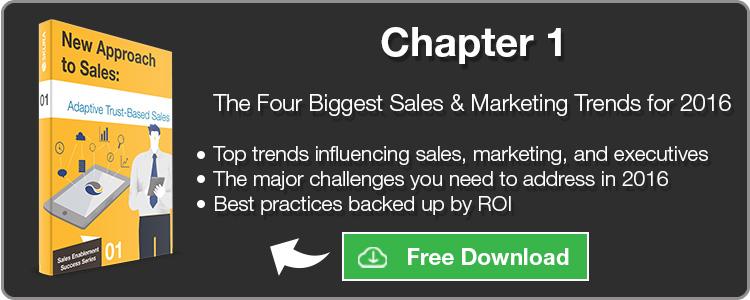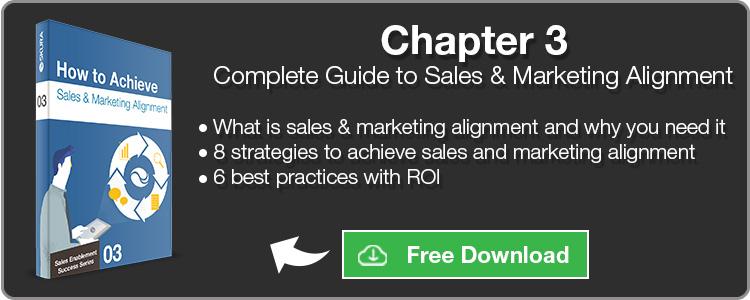The importance of mapping and understanding buyer personas is crucial, as it can make or break your company’s sales operations and communications. Through sales enablement software, creating playbooks tied to personas enables a number of strong benefits such as more tailored communications, a more conversational sales call approach, and overall improved sales and marketing alignment through streamlined efforts.
But what is a buyer persona, and how is it impacted by sales operations? This week we examine these factors and provide some enticing insights on the subject.
What Are Buyer Personas
Having a great business plan and product/service is an important aspect of any business, however, if you don’t have a real understanding of your customer base, you’ll struggle with the longer term impacts of an empowered buyer. A one-size-fits-all marketing plan may work for a few companies out there, but in most cases, not being focused can do a lot of damage (Source: Forbes, 2014). When it comes to marketing, the most important goal is to determine who your target audience is, and what they need in terms of company communications.

Interpreting customer preferences is rarely a black and white factor. The range of customer tastes and their place in the decision journey means that no longer can we think of our customers as perfect cookie-cutter cut-outs. Instead, we have to understand these complexities. One way in which this can be done is through the mapping of buyer personas.
[RELATED CONTENT] Why are personas so crucial? Four critical trends are influencing new challenges in sales and marketing. Learn more about these trends, and the best practice solutions you can use to mitigate the challenges.
Creating buyer personas helps to better profile your target audience. Buyer personas help you to create a representation of what your customer base looks like based off of real data about your existing customers (like content consumption) and form-wall completions. The process of defining and optimizing buyer personas can be enhanced with the help of sales enablement software.
With personas, it’s all about providing the right set of communications that make the decision journey a painless, and rather delightful experience. When buyers see your company’s ability to understand, and react to, how they approach the buying decision, you are able to build trust. (Source: Buyers Persona Institute, 2015).
Before we go on about personas, you may like to have a read from this blog post about the importance of being conversational, with tips to getting more out of your sales presentation. The empowered buyer is profiled and explained, as well as some reasons for why trust is so crucial, and hard to achieve.
Determining Buyer Personas
There are a number of different ways that we are influenced in making a purchase decision, from the influence of our backgrounds, to family and friends, even to our own personal beliefs. No two decision journeys are entirely the same. As a result, understanding and profiling your customers isn’t always clear or easy. Businesses need to understand that buyer personas are much more than a one-dimensional profile, rather they are multidimensional (Source: Buyers Persona Institute, 2015).
On average, only 25% of buyers actually reveal their interest and where they stand in their decision journey to Sales Reps (Source: Kapost, 2015). This awareness gap is what makes persona mapping so crucial, as the empowered buyer expects a more tailored discussion, and digital content makes capturing those details an automated process.
Companies that invest in digital sales aids are able to monitor these kinds of KPIs. By doing so, they can understand what stage the buyer is at, and are better able to develop a buyer persona for various stages of the decision journey.
Looking for more ways to understand your KPIs? You might find our previous post, “The devil is in the details: Sales enablement KPI” helpful.
When profiling your customers, there are three dimensions to consider: demographics, behaviour patterns, motivations and goals (Source: Hubspot, 2014). The more information and details that you can learn about your buyer, the better (Source: Hubspot, 2014).
Demographics
Determining the demographics of your customers is a good starting point, though it does not specifically tell you everything you need to know in order to create a well-rounded buyer persona (Source: Forbes, 2014).
What demographics do for personas is to help you tailor the kinds of communications you will have, and mediums you’ll engage through. For a simple example, a younger persona may be more receptive to engagements via social media, where an older persona may enjoy an old-fashioned phone call.
But this is just a simple example, more comprehensive demographics like the specific job they hold in the company will enable you to provide tailored communication pieces, not just target preferred mediums.
Often what occurs in sales is that the sales rep locates a lead, and adds them into the CRM system. Having a strong sales enablement platform allows the rep to immediately update the CRM system, and apply content consumption insights to that persona from the very first interaction.
Thus, integrated CRM and marketing automation platforms make this entire process an accurate and effective strategy that delights the buyer experience from first contact.
Behaviour Patterns
You’ve probably heard time and time again that actions speak louder than words. When it comes to your buyer personas, this statement stands true. Especially when you consider that sales reps manage the discussion at the latter stages of the decision journey. Analyzing buyer behaviour and purchase patterns can tell you a lot about your audience.
Sales enablement tools have the ability to collect and analyze data through integrated sales analytics software dashboards. This data can tell you things like who the information is being presented to, what information is being presented, and how much time is spent with the information.
Behaviour patterns help you understand the potential of each engagement, the likeliness of someone making a purchase decision, and the things that influence the buyer in general. This is accomplished through content consumption insights, and is why sales enablement software should always come accompanied with analytics solutions.
But personas don’t only focus on pre-sale interactions, because as we know, the sales process doesn’t end at the sale. There are ample opportunities to enhance the relationship post-sale. Moreover, you could have customers who are unhappy and or confused with the solution because they aren’t getting the most out of it.
Mapping these personas, their common concerns, and engagement with content, can enable you to provide a more tailored post-sale experience, and actually enhance customer retention over time.
Overwhelmed by your data and analytics? We discuss “How to choose the right metrics for your sales process” in our previous post here.
Motivations & Goals
Understanding what motivates a customer to make a purchase decision and their end goals can be a complicated process. According to buyers, 51% feel that brands are underperforming when it comes to asking about their needs (Source: Conversion XL, 2015).
One of the most important steps when creating a buyer persona is to understand what your current customer is experiencing, the issues that confront them, and the results they expect to see from doing business with you (Source: Forbes, 2014). Using sales enablement software that integrates with your current CRM system can give you a better understanding of your customer’s decision journey and motivations.
Through integrated CRM, sales reps can automatically record interactions with customers, including important information that may have been disclosed through conversation. Recorded conversations can let you understand the motivations and goals of the customer. These interactions are also important because they can then be used as quantifiable data.
Once you know a customer’s goals, it is also important to take a step back and see if there are any obstacles in the way of the customer making a decision. Taking the time to understand their hesitations and concerns means that you ensure they have the right information they need to complete their decision journey (Source: Conversion XL, 2015).
Interested in learning more about how CRM can enhance sales enablement tools? Check out our other post, “Connecting the dots with CRM and mobile sales enablement integration” here.
How Buyer Personas Effect Marketing
Knowing your buyer persona is vital in determining the success of your marketing efforts. You may know your ideal buyer (CMO, HR Manager, etc.) but without a way to understand the effectiveness of marketing efforts, you’re really shooting blind and hoping for the best.
Before I proceed here, I invite you to take a read of this post from Peter Ostrow, who guest blogged for us and composed a piece about understanding which half of your marketing budget is working.
Buyer personas matter for content because they allow you to continually enhance the quality of content while improving overall buyer awareness.
If you’re a marketer, I can probably read your thoughts already. You’re probably thinking that you have several buyer personas mapped, and you use the content consumption stats from your Marketing Automation system to enhance personas and rate content.
Firstly, if you’re not doing this, it’s an amazing place to start, as it will give you a great level of awareness into which content is actually effective for things like lead generation and lead nurturing.
The challenge with marketing automation (MA) is that it doesn’t actually tell you anything valuable about the effectiveness of your content for closing sales. A Marketo sales and marketing alignment study for 2013 reported that MA had no measurable impact on late stage sale closure, likeliness of SQL closing, or ratio of MQL closing. (Source: Marketo, 2013)
But why?
Well, it has to do with scopes. You see, MA is incredibly powerful, and enhances marketing contribution to revenue as well as lead generation. As a result, you can optimize your content for lead generation and nurturing over time, but MA doesn’t keep track of what your sales reps are doing.
And therein lies the challenge of why a lot of content doesn’t actually add value to the decision journey.
In the United States alone, an estimated $950 million is spent every year on inefficient content production (Source: Kapost, 2015).
What tends to happen is MA metrics enhance lead generation, and thus that content is enhanced to reflect those metrics. But we know that buyers at the end of the decision journey have a very different set of needs than those at the beginning.
And the result is a damaging blow to the perceived sales rep effectiveness because of content communications that don’t help progress the decision journey near the end of the sales funnel.
If you’re starting to grasp this challenge, I think you should take a look at this post about the 2 reasons that sales training fails to improve the sales process. You’ll see stats about how buyers feel about sales reps, the impact of content marketing, and why so many companies are missing the mark by focusing on sales training, instead of buyer insights.
Sales and Marketing Alignment for Buyer Persona Awareness
As we have discussed many times on our blog, the nature of Marketing and Sales is shifting. Now, more than ever, Sales and Marketing must work together in unison. It is no secret that marketing works to generate leads, while sales works to nurture those leads into customers. One cannot simply work successfully without the other, and as a result, sales and marketing alignment is a necessary strategy in the sales process.
Sales and marketing alignment is also critical when it comes to understanding your buyer persona. Information about your customers gathered by your marketing team works in conjunction with information gathered by your sales team. Marketing can only portray half of the big picture. (lead generation, but not closing)
By analyzing engagement throughout the decision journey, marketing and sales will be able to participate in stronger collaboration together (Source: Zambito, T. 2013). The interactions that your Sales Reps have with your customers is vital in understanding and filling in the holes that marketing cannot.
At each stage in the decision journey, 77% of buyers expect different content to reflect where they are in their journey (Source: Kapost, 2015). Working with sales through mobile sales applications will allow marketers to better understand where customers fall in their journey. Instead of focusing on over generalized content, marketers must focus in on supporting the buyer’s goals and helping to complete their path-to-purchase (Source: Zambito, T. 2013).
Still not sure why or when you should consider sales and marketing alignment? We break it down for you in our previous post, “Why use sales and marketing alignment, and 5 best practices”.
At the end of the day, if you don’t understand your customers you can’t expect them to want to work with you. Understanding buyer personas are a critical process in order to be able to build better relationships with your customer.
While Marketing Automation does provide extensive insights, it doesn’t help you optimize for sales rep insights. That knowledge is where the real determining factor for content effectiveness comes into play; the final sale.
Real sales enablement pushes content consumption insights into marketing automation, drives stronger sales and marketing alignment, and enhances deep persona awareness while enabling sales reps to deliver content to the right person, at the right time, in the right place, every time.
[RELATED CONTENT] We helped a major multinational pharma company, GlaxoSmithKline, realize the power of tailored buyer-centric communications enhanced through buyer persona targeting. I invite you to check out the free case study below for a look into how sales enablement drives significant awareness at every level.
If you want to get a real look at how adaptive sales enablement can help enhance your end-of-funnel persona-based communications, request a demo and let us show you a new way to do business.














